#mycoTEX
Explore tagged Tumblr posts
Text
If I read a SINGLE more fashion article about mycoTEX that calls mycelium “mushroom roots” I WILL scream.
#that's the fungus right there! the fruiting body is just a gotdamn fruting body! its more like a dick than anything!!#do not insult mycelium in this manner!#also none of the articles so far have specified WHAT FUCKING SPECIES the damn mycelium COMES FROM#please I jsut want to know how accessible this material is#shitpost#fashion#science#mycoTEX#mycelium#fungi#fungus#textiles
10 notes
·
View notes
Note
how do mushrooms make textiles
just wanna clarify that is it not the 'mushroom' (fruiting body, the penis of the fungus) they use, its the mycellium!
when you culture fungi in a petri plaque, you can actually clasify the mycellium according to its appearance: some species are really soft and velvety, some others form granules and some are team sludge, fuck yeah! The first type i mentioned is particularly apt for it because it dries like this!
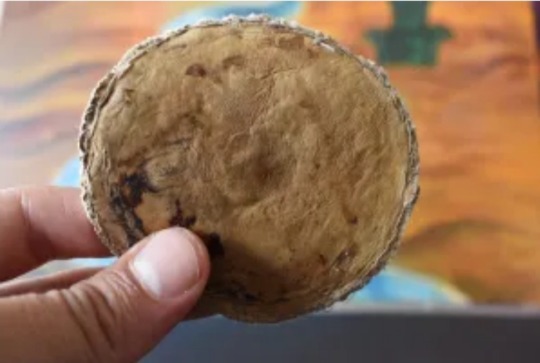
(Credit to the chilean startup Sporatex)
Thats the raw material, lets say. Its warm, durable, and easy to make. Hell, I made these by accident in my first lab job. Right now, scientists are perfecting the process of turning the raw material into individual fibers to weave, but even like THAT it can be turned into something beautiful!

(Credit to MycoTEX)
37 notes
·
View notes
Text
The Rainbow Connection
Pairing: Ezra/Male! Reader
Word Count: 2,123
Warnings: canon-typical violence and language.
Permanent Taglist: @phoenixhalliwell @star-wars-hell
It is week two of pride month! As I have said, I am participating in @flightlessangelwings and @autumnleaves1991-blog Pride writing prompts! This one was super fun for me, and I hope you enjoy.
Prompts: Rainbow and/or “Hold my hand tight. I’ll protect you.”
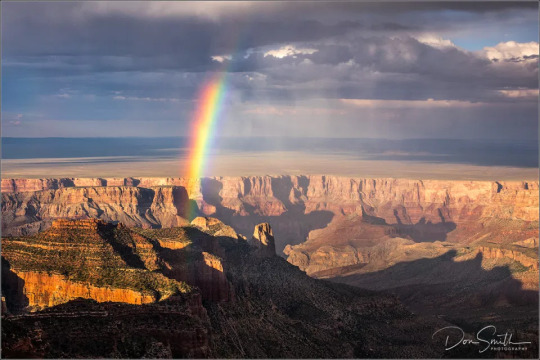
“Babe?”
You rolled over, groaning and putting your arm over your eyes. You and Ezra had been prospecting on a truly hellish desert planet for nearly a week now, and the three suns made the sky as bright and as hot as it could possibly be. It filtered through the pod’s tiny window, lighting the entire room. “Yes Ez?”
Ezra smiled down at you, putting his hand on the bed and leaning in to kiss you. “Good morning dove.”
“Did you wake me up just to say good morning?” You asked, rolling out of bed and fumbling for a pair of pants. You ended up grabbing Ezra’s from the night before off the floor, but he didn’t seem to mind. In fact, he stared rather obviously at where the elastic met your bare waist, the skin marred by scars you’d gotten while working.
“Hey, Casanova,” you said, turning and catching Ezra staring. “What’s on the agenda for today?”
Ezra smiled, leaning against the bed. “They just found a new deposit of zipreye out a few miles north. It’ll be a hell of a trek, especially in this weather. Hot as the devil out there.”
You sighed, grabbing a tank top out of your travel bag. “Think I should just go topless?”
“Might feel better,” Ezra decided. “But you might burn, so grab the sunscreen. And don’t forget your boot covers this time.”
“Mhm,” you hummed, tugging on thin socks and your heavy hiking boots. “And you better not forget your glove again.”
After a long and lazy breakfast, you and Ezra left the pod you were temporarily calling home and started traveling north, both carrying your prospecting equipment. The heavy bags combined with the suns and the physical labor of walking made you groan more than once. The air was barely breathable, and it felt like thick soup going to your lungs. Multiple times you had to stop for water, leaning against Ezra, who was just as tired as you were.
By the time you arrived at the dig site, you were both sweating and exhausted, but the scenery made up for it. The site was settled on the very edge of a giant canyon, at least a hundred feet deep and streaked with color as far as the eye could see. The sky was growing grey and cloudy, the sunlight filtering through creating pockets of sunshine shining on the rocks. The air was cooler out here as it swelled up from the depth of the canyon, and you took a deep breath of the sandy air, eyeing the rapidly growing clouds.
“Think it’ll rain?” You asked, turning to the dig site and kneeling down so you could unpack your stuff.
Ezra shrugged, sitting cross legged on the dirt so he could unload his own bag. “Dunno. I like that shirt on you, by the way.”
You smiled, looking down. In an effort not to get horrifically sunburnt, you’d put on a thin white shirt with short sleeves and a hood. “Thanks. I think it’s yours.”
“Ah, well, that would explain it.” Ezra smiled as he squinted at the sky. “It does look like rain, but it’s far off. We have an hour. Maybe two, at a push.”
You nodded, bending down. Zipreye was one of the easier minerals to prospect, with no need for acids or dangerous conditions to battle against. All you had to do was find a deposit and chip it out, piece by piece. It was harder for Ezra, with only one hand, but he made it work. The reward was enough for you two to finally take a vacation after this trip. You two were planning on visiting Cee, who had joined a few distant family members on a perfectly habitable and safe planet. It would be a nice break from the chaos of planet hopping and hoping to find a job.
You and Ezra had been prospecting for nearly an hour and a half before you felt the air shift for real. It had been stirring the sand for a while, but now it started to truly whip your lighter equipment around, making you look up and see the suddenly very dark clouds completely blocking the sun. The temperature began to drop noticeably, and you carefully lifted the chunk of zipreye you’d been harvesting out of the ground before beginning to pack up.
“Dove?” Ezra looked up at you, confused. “What’s wrong?”
“The rain,” you said. “Can’t you feel it?”
Ezra sat back on his heels and took a deep breath. “I can,” he murmured. “Let’s go, before it hits us.”
You weren’t very lucky, and the rain began to pour a mile or two away from the pod. It stung your skin and soaked your bodies, making your clothes stick to you and forcing Ezra to push his hair out of his eyes every few seconds. It took everything you had to keep your equipment as dry as possible, the bag at your side shielded by your body and the waterproof backpack getting absolutely drenched.
“Pod’s just up there!” Ezra yelled above the downpour, pointing to a familiar looking ridge. “C’mon!”
You grabbed his hand, continuing to trudge through the rain. It was seriously coming down, and it burned badly enough that you had to wonder if it was acidic.
“Ez!” You shouted, tugging on Ezra’s shirt to get his attention. “This planet doesn’t have acidic rain, does it?”
Ezra shrugged, looking at his bare skin. It was starting to get red, and so was yours.
“We have that soap with the burn relief shit in it,” Ezra said, pulling you closer. “And a thing in the first aid kit. It’ll be fine, even if the rain is acidic. We would’ve been issued a warning and suits if it was dangerous.”
You nodded, looking out over the blank horizon, hoping you’d be able to see your temporary home soon. The landscape did look familiar, and you sighed deeply. Taking another soggy step, you decided today could not get much worse.
Of course, it somehow could, because the pod was just barely in sight when Ezra was attacked.
Something large and soaking wet came running up out of nowhere and swung a large weapon at Ezra, catching his indefendible right side. Ezra yelled loudly, flinching away as the attacker got a lucky strike in.
You screamed as Ezra bumped into you, grabbing your dagger off your belt and immediately pulling Ezra back behind you, away from the attacker. The man, at least you thought it was a man, made a blind swing in your direction, but you were quicker. You whirled around him, grabbing his throat and shoving him down. Two quick moves with your knife later, and you were standing, wiping blood off your knife and letting the rain clean up the rest. Ezra, who had been knocked to the ground, winced when you pulled him to his feet, blood washing away as it hit the sand, but he was definitely bleeding.
“Did he get you?” You asked, checking Ezra over as best you could.
Ezra nodded, moving his hand off his right stump. “My shoulder.”
You hissed, seeing the tattered wound. “Disinfectant,” you said. “A bandage. But no stitches. You’ll be a-okay.”
Ezra shrugged, still shaking as you reached into your bag for a temporary bandage. You tore the bottom off your shirt and used it to tie the gauze pad in place, effectively giving yourself a crop top.
“Hey,” you said softly, reaching out and taking Ezra’s hand when you were done. “Hold my hand tight. I’ll protect you.”
The walk to the pod was quiet. The rain was starting to let up, finally, and after drying off somewhat, you herded Ezra into the kitchen so you could examine his arm. Both of you were covered in mild burns from the rain, but after careful consideration, you decided that cleaning Ezra’s wound and taking a nap would be best. You two could bathe and treat your burns later, but for now, you removed the current bandage and discarded it in the sink, taking another look at the sluggishly bleeding injury.
“Looks worse than it is!” You announced, putting on a pair of sterile gloves and opening your first aid kit. “I promise. It just needs disinfecting, like I said.”
Ezra fidgeted from his spot at the tiny kitchen table as you grabbed a towel and used warm water to wipe away the worst of the mess. “Sure?”
“I’m sure,” you said, opening a can of spray-on disinfectant. “This’ll sting.” You braced Ezra’s shoulder with your non-dominant hand and sprayed the wound with the other. His face twisted with barely concealed pain, and you took a breath. “Ez?”
“I’m fine, dove,” Ezra said, although it sounded strained. “Fine. Keep going.”
You nodded, continuing through the motions of cleaning and bandaging Ezra’s wound. Somewhere in the middle of the process, you started to sing. It was a mindless lullaby, but Ezra seemed to enjoy it.
“Why are there so many songs about rainbows, and what's on the other side? Rainbows are visions, but only illusions. And rainbows have nothing to hide.” You pressed the last piece of tape to Ezra’s arm, gently kissing the patch of gauze. “So we've been told and some choose to believe it, I know they're wrong, wait and see. Someday we'll find it, the rainbow connection. The lovers, the dreamers and me.” You pulled your gloves off and threw them out, coming back to stand in front of Ezra. “How’s that feel?”
Ezra smiled, resting his head on your shoulder. “It feels fine,” he decided softly. “I love you.”
“I love you too,” you said, putting your arms around Ezra and holding him close. “Do you want me to put something on those burns or would you rather just go straight to bed?”
Ezra shrugged. “Do we have any quick burn stuff? I don’t want a shower right now.”
You chuckled slightly, digging through the first aid kit and finding a bottle of burn lotion. “You said you need to use mycotex, right?”
“Yeah,” Ezra said, not removing his head from your shoulder. “I’m allergic to the other stuff. What is it?”
“Acitretiza,” you said. “My mom used it all the time.” As you spoke, you gently rubbed Ezra’s tender shoulders with the lotion, hearing him sigh with relief as the lotion began to cool and heal his burns. “Works better to help scars, but I think mycotex feels nicer.”
“Amen to that,” Ezra mumbled into your skin. “You ruined your shirt, by the way.”
You looked down at the ripped edge of your shirt. It was bloody and unrepairable, and you were a tiny bit disappointed. “I can always find a new one,” you said, continuing down Ezra’s back and digging your thumbs into the knots under his skin. “Maybe I’ll get you one this time.”
Ezra chuckled, taking the bottle of lotion from you and motioning for you to turn around. “Cee would have a field day if she saw us in matching shirts, and you know it.”
After you and him had both rubbed the lotion into each other’s skin, accompanied by no less than six thinly veiled sexual comments, you decided it was time for a nap. Ezra’s eyes were dropping and he was clearly exhausted from the job and from the trip home.
It was no struggle getting Ezra into bed. Neither of you bothered with your barely damp clothes, so you left a trail of discarded clothes to the bedroom, leading up to the bed. Pyjamas were a fruitless endeavor, so you just grabbed a second blanket so neither of you would be cold. Ezra fell asleep first, snoring slightly as you sat beside him, working on your laptop. At some point, you got up to put on pants and an old shirt of Ezra’s. As you worked on mind-numbing files, you hummed, unable to get the song you’d been singing earlier out of your head. Turning to look at Ezra, you smiled, watching his side rise and fall gently as he slept, completely oblivious to your actions as you bent down and kissed his temple.
Sitting back up, you looked out the window, seeing a beautiful and vibrant rainbow illuminating the canyon you’d just been prospecting near. The rain had left the earth wet, and it glimmered like a thousand diamonds under the afternoon sun. The scenery made you grin, nodding your head slightly as you went back to work, your humming turning to soft singing.
“What's so amazing that keeps us stargazing, and what do we think we might see? Someday we'll find it, the rainbow connection. The lovers, the dreamers and me.”
#prospect (film)#ezra (prospect)#ezra x reader#ezra x you#Pedro Pascal#My writing#writer wednesday#jey's pride celebration 2k21
34 notes
·
View notes
Text
Fungi: fabric of sustainable fashion
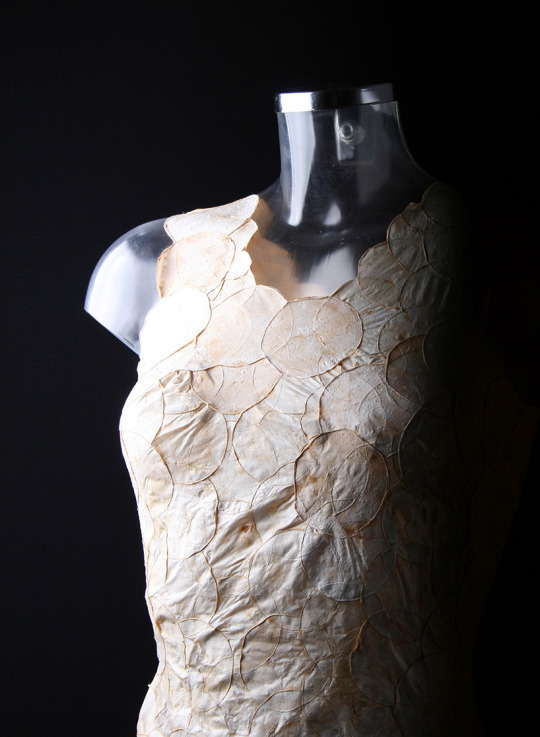

(Image caption: Left: MycoTEX (a type of mushroom fabric) dress credit: Aniela Hoitink. Right: nat-2™ x Zvnder vegan sneaker line made from real fungus | Fomes fomentarius! credit: www.nat-2.eu)
Fungi are sprouting everywhere- from fashion runways to personal clothing wardrobes!
No, this is not the first time that we are spinning something out of these moisture loving small organisms. A new study confirms that native Americans were already producing “mycotextiles” at least a century ago. But it is recently that certain types of fungi taking the world of fashion by storm.
You still might unheard of that fungi can now be fashioned into clothing, purses, pants and even sneakers but this new reality is taking the fashion world in its grip.
Last year, a number of major fashion brands — Lululemon, Adidas, Stella McCartney and Gucci’s parent company — teamed up to invest “seven-figure sums” to create clothes and shoes made out of mycelium fabric with Bolt Threads, a US based biotechnology company. In fact, the mushroom market is speculated to reach a valuation of over $50 billion by 2025, according to Grand View Research.
What is leading this newly heightened appreciation for this thalloid organism?
Fashion industry has got a bad fame for very high water usage, pollution and a high carbon footprint. It is actually the world’s second-most polluting business, behind oil, as stated by the United Nations and hence, is witnessing criticisms from all corners- one such being disruption of London Fashion Week by Extinction Rebellion. Given this, right now a sustainable wave is sweeping across the fashion arena and there is more than ever pursuit for an eco-friendly means of production.
Among other innovative solutions, development of biotextiles is one because textiles have a big carbon footprint and clog landfills when discarded. In this quest, mushroom based fabrics are emerging as an exciting, aesthetically viable material alternative.
Jamie Bainbridge, product developer at bolt threads sums this up in an interview to forbes "I’ve spent a career developing materials and I’ve never seen a material with this much pull, I’ve never seen anything like this (mushroom fabrics).
What makes mushroom fabrics to stand out?
Fungi are naturally abundant in the nature and grows swiftly (on a range of waste materials like tree mulch and vegetable wastes). Different types of fabrics have been created from fungus by using different material combinations. Mycelium, lattice-like root structure of fungus, has found its many admirers in the luxury industry. Mycelium can be easily grown on a petri dish in a lab and their growth uses a lot less water than traditional textile manufacture, moreover, with no requirement of chemical fertilizers. The materials are actually made to order and there’s absolute transparency into what is being made and how. Even, we can tailor mycelium materials’ properties, for example, size, strength, flexibility, thickness and can make them hard as enamel or as soft and porous as a sponge, by altering the amount of light, humidity, exchange of gas, temperature, and types of “food” the fungi is given, this renders them as the ideal creative material for whatever you desire forging and also, being it carbon-negative, it can be naturally dyed to any colour. This customisation creates a range of design possibilities and guarantees consistent quality. There is no need for cutting, sewing, knitting etc. so, less waste is generated in the process.
Additionally, mushroom fabrics are non-toxic, fire-resistant and naturally anti-microbial (unlike other textiles, which are only made to be anti-microbial through an expensive process). In contrast to a lot of textiles, the insulating and hygroscopic properties of mycelium are very good. Most importantly, the fabric is 100 per cent biodegradable. Consequently, once a mushroom garment has reached the end of its life, it provides nutrients to the soil for other plants, forming a perfect ecological cycle.
How the future of fungi looks like?
There are still lot of uncertainties and questions about the logistics of wearing and producing mycelium. Fungal biofabrication is a labor intensive and time consuming process. For instance, it typically takes anywhere between eight to ten days to grow material for a dress. This poses challenges for production on the commercial scales. To add on this, supply chains don’t seem to be ready to handle an influx of mycelium production yet. These factors come together to add on the logistics cost of the product hence, often, rendering them prohibitively expensive for many consumers.
As mushroom based clothing and other accessories are still a new material, plausibly, it takes a while to earn reputation, acceptance, and having significant presence in retails.
Take-home message: In these times of deep climate crisis, we need to strengthen our bonding with nature and in this, mushroom can make a catwalk to a more greener future.
#sustainable fashion#Future of fashion#climate crisis#fungi#Biofabrication#Fabrics#world of fashion#mycology#radical culture#catwalk#ecofriendly#science of fashion
12 notes
·
View notes
Text
Mushrooms as raw material for leather accessories and clothing

Nowadays, various mushroom species form the raw material for producing alternatives to leather or (plastic) artificial leather and clothing. With such a program, start-ups succeed in raising money to further develop their activities.
For example, there is MuSkin: a 'leather' made from mushrooms. More animal-friendly than real leather, suitable for vegans and no chemicals are used during tanning, which makes it nice for your skin. In Europe, MuSkin is produced by the Italian company LifeMaterials. The 'mushroom leather' is mainly bought by exclusive fashion designers who make hats, watch straps and bags from it, among other things. The Belgian shoe designer Kristel Peters[1] has already made a shoe with Muskin that is completely biodegradable. The vegetable leather is also very popular, the demand exceeds the current supply due to the limited production capacity. Fortunately, there are plans to ramp up production in the near future. [2]
The British Amadou Leather, for example, is developing biomaterials from mushrooms as a replacement for leather. The mushroom material is grown on recycled sawdust and is cultivated using edible mushroom cultivation technology. The material is brown in color and has features including better tensile strength, malleability, biodegradability, compostable, lightweight, flexibility, and is antimicrobial. It is claimed that the material, when worn, absorbs moisture and insulates heat. It can be used in fashion, furniture, automotive, and transportation industries.[3]
The Hermès Victoria Fall/Winter 2021 (prices start from around £3,500 for its previous leather version) will be made from Sylvania, a leathery fabric created from fungus, before being crafted in France into a perfect Hermès handbag. [4] Hermès worked with the Californian company MycoWorks[5] to make Sylvania, which uses a technology called Fine Mycelium. This produces a strong cellular material that can be processed to give a luxury leather effect. Mycelium, the root structure of fungus, has become a favourite in the luxury industry.
Start-up MycoTEX makes clothing from mushroom roots
The start-up from the Dutch city of Soest, MycoTEX, receives an investment to further develop their new technology for making clothing from biomaterials such as mushroom roots. As a result, the products require less energy, water and chemicals than materials such as leather and textiles.
The company is developing a technology with which clothing and accessories can be made from biomaterials, such as mycelium - also known as mushroom roots. “By focusing only on material improvement, we cannot make the fashion industry fully circular. That only works if one also changes the entire production chain,” says CEO Aniela Hoitink.
The clothing is made in such a way that it fits together seamlessly. This means that the pieces do not need to be sewn together and that common steps such as spinning yarn, cutting fabrics and sewing clothes are skipped. The garments are made without stitching, without waste and to measure. The process uses no chemicals and pesticides and reduces CO2 emissions and water consumption by up to 50 to 70 percent. Because the garments can be made locally, little transport is required.
With this first investment from the ifund foundation[6] and the Regional Development Agency[7] (ROM), MycoTEX wants to further develop its materials and production method. MycoTEX cannot share the investment amount, but says it will release a pilot collection next year. “In this way, we are striving with the company to revolutionize the current production chain”.
Source
ROMY DE WEERT, Start-up MycoTEX maakt kleding van paddenstoelenwortels, Change Inc, 2-11-2021, Start-up MycoTEX maakt kleding van paddenstoelenwortels | Change Inc.
[1] Kristel Peters is SHOE DESIGNER @Studio COJAK – and consults in circular economy, design, develop and educate in order to create a bridge between explored bio-& natural materials and emerging technologies to act direction sustainability for human & nature. Shoedesigner – Future proof designs and consultancy [2] Nieuw: 'leer' van paddestoelen | Voor de Wereld van Morgen [3] Amadou Leather | Tracxn [4] It’s this season’s must-have Hermès bag. And it’s made from fungus | Fashion | The Guardian [5] MycoWorks is a biotechnology company founded by artists with the mission to create a platform for the highest quality materials using Fine Mycelium. Drawing on over three decades of pioneering research and innovation by our creative founding team, MycoWorks’ proprietary Fine Mycelium platform has enabled a new class of premium, non-animal materials that are the next evolution in mycelium. They use the tools of biotechnology, manufacturing excellence and creative, master craftsmanship to grow the future of materials. Home - MycoWorks [6] Stichting ifund (the ifund foundation) stimulates the transition to a sustainable world by helping innovative social enterprises. It finances and supports entrepreneurs who focus on a sustainable and local supply of energy, food, water, or raw materials. ifund [7] Each Dutch province has a Regionale Ontwikkelingsmaatschappij (Regional Development Agency). These ROMs aim to strengthen the regional and local economy. ROM's – De regionale ontwikkelingsmaatschappijen in Nederland (rom-nederland.nl)
0 notes
Text
0 notes
Photo

MycoTEX es un material 100% biodegradable hecho de micelio https://ift.tt/2k2gyry
1 note
·
View note
Photo
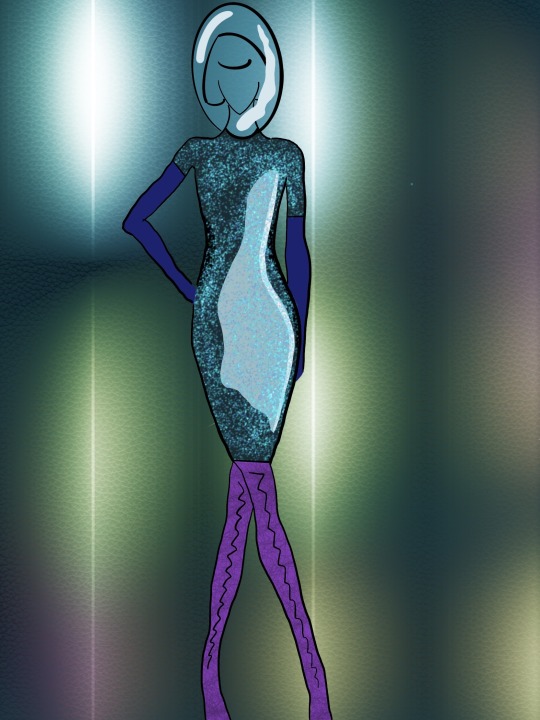
Random thaught 02
2021
if the world came to an end and we had to move would we think about fashion and making the spacesuits look fashionable?
Would we worry about what someone else wore?
I find that a lot of people are materialistic so would the “dress to impress” work on Mars?
Bioluminescent spacesuit (dress) - reaserch/ideas on sustainable fashion
The idea is to use bioluminescent bacteria in fashion. How ?
We know it is possible to make a dress out of fungi but would it be possible to make it out of bacteria (bioluminnescent bacteria to be exact)
The fashion world makes a lot of unnecessary waste that has a huge impact on the inviroment.
Especially the fast fashion companies they are the worst.
The main question is why do we even make clothes that can last up to 30 years but we mostly wear it for one or two max.
What if we connected with nature in a way that we made clothes not from fibers (fibers go trough a lot of chemical proccesses before they are actually made into textiles and that proccess is also very damaging to the enviroment) but fungi and bacteria which is easily compostable and we also don’t have to go trough chemical processes.
Also, this is just an idea to make a dress out of bioluminescent bacteria I wouldn’t say it is not possible but It would be without a closed ecosystem as bioluminescent bacteria doesn’t have the ability to survive in most conditions.
Ref.:
https://neffa.nl/portfolio/mycotex/
https://www.dezeen.com/2016/04/01/aniela-hoitink-neffa-dress-mushroom-mycelium-textile-materials-fashion/
https://www.bustle.com/p/clothing-made-of-mushrooms-might-just-be-the-future-its-actually-pretty-cool-8018663
https://www.wur.nl/en/newsarticle/Sustainable-clothing-made-from-fungi.htm
https://settingmind.com/biodegradable-clothing-textile-made-from-fungus/
https://sustainabilityinstyle.com/fungi-fashion/
https://www.smithsonianmag.com/innovation/biofabric-mit-uses-bacteria-automatically-ventilate-workout-clothes-180963478/
https://www.dezeen.com/2019/07/23/rosie-broadhead-weaves-bacteria-into-clothing-fibres-to-create-a-second-skin/
https://www.sustainyourstyle.org/en/fiber-ecoreview
https://medium.com/@madetrade/5-innovative-fibers-in-ethical-fashion-and-sustainable-design-29f4f6138ddf
Book: “Smart textiles for designers”
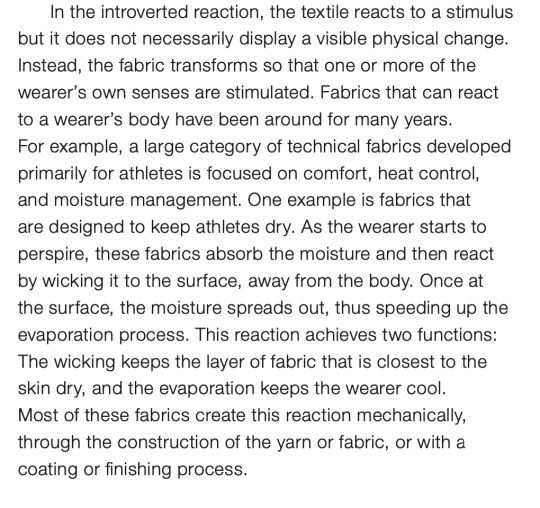

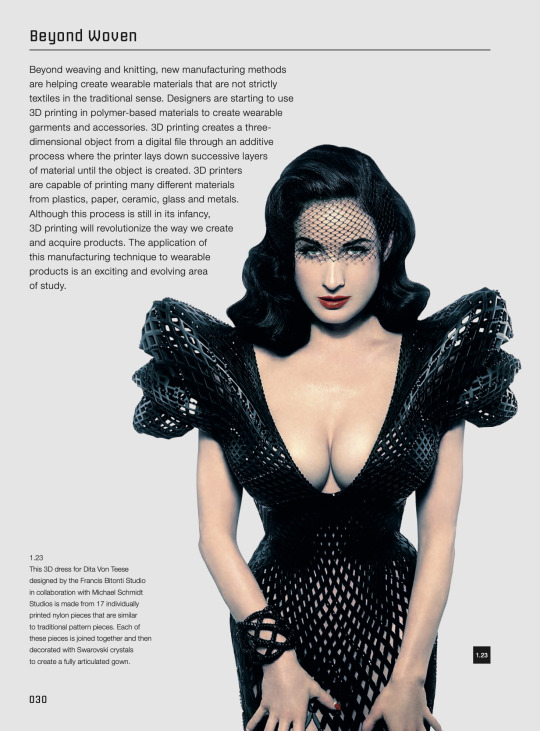
0 notes
Text
New and smarter textiles race to the future of fashion

The clothing of the future will look nothing like what we wear today. Or maybe it will.
A hunger for sustainability is leading researchers to new organic materials from which to design clothing.
Other visionaries are working to make our future outfits as smart as we want to look.
None
One of the fun things about watching science fiction movies, especially old ones, is seeing filmmakers' sometimes daffy predictions of what future clothing will look like. A lot of these prognostications envision traditional fabrics such as cotton or contemporary synthetic fibers cut into "future-y" designs. Recent advances make the real future of clothing look much more imaginative: While some are busy discovering more sustainable materials from which to fashion our clothes, other are dreaming up new things for our outfits to do.
Nature knows best

About 60 percent of the clothing we wear contains plastic microfibers. The best-known are polyester, nylon, and acrylic. Unfortunately, these fibers don't stay in our clothing. While some of them leach out as we go about our business, taking to the air and so on, doing laundry may be a significant contributor to the 8 million tons of microplastics dumped into our oceans annually. (Fun fact: Experts only know where about 1 percent of that plastic goes.) Nonetheless, research published in 2016 says that for an average wash load, over 700,000 fibers could be being released into the water supply.
In addition to ongoing efforts to find new ways of incorporating used materials in new clothing, textile-industry scientists are experimenting with a range of less environmentally damaging, more sustainable materials for us to wear. Much of it is derived from naturally occurring sources.
Pineapple fabric
Piñatex is a leather substitute made from pineapple-leaf fiber. These leaves are discarded during harvesting of the fruit, and so they're readily available with no additional farming necessary, according to the Piñatex web site. The material, which is produced in sheets, is already being used for making shoes, handbags, and dresses.
Mushrooms
There are a few mushroom-thread-based fabrics.
There's a synthetic leather called Mylo, from Bolt Threads, a vegan, eco-friendly material. The company's partnering with fashion brands Stella McCartney and Patagonia in making actual clothing from Mylo.
Then there's MycoTEX. The most startling thing about MycoTEX is that this living material can be grown into clothing. As producer Fungal Futures puts it, "the garment can be built three-dimensionally and shaped whilst being made, fitting the wearer's wishes," using clothing-shaped molds. Since MycoTEX grows into the desired shape without cutting, there's no waste material when a garment's complete.
Not-silk
One of the wildest ideas is another technology from Bolt Threads called "Microsilk." Based on the way in which spiders produce real silk, Microsilk is derived from yeast-based proteins, extracted, and then spun into fibers. The company released, and immediately sold out of, a Microsilk tie in 2017, and Stella McCartney showed a gold dress made from the fibers at NYC's MoMA that same year.
Eucalyptus yarn
A company called Wool and the Gang (a pun better read than said) is selling a product, "Tina Tape Yarn," made from sustainably harvested eucalyptus trees. They call the material Tencel and claim it's "more absorbent than cotton, softer than silk and cooler than linen." It's also biodegradable, made with renewable energy and — heads up, sheep — totally vegan.
Agraloop BioFibre
This company takes plant-based textiles beyond pineapples. We say that because pineapple leaves are just one of the castoff materials sourced to make their line of BioFibres. The others are oil-seed hemp, oil-seed flax, banana tree, cane bagasse, and rice straw. Agraloop notes that these six crops provide 250 million tons of textile fiber per year, 2.5 times the global demand.
Some of the rest
Other natural substances being reworked into clothing include chitin fiber from crustacean shells, seaweed, banana fiber, coconut fiber, and corn fiber.
Don’t forget to recharge your underwear

Technology in textiles is not a new thing, but it's a booming field. Antimicrobial silver nanoparticles that prevent smelly bacteria — and therefore require less washing — have been embedded in fabrics since early in the new millennium. Researchers are working on water-repelling fabrics, and nanoparticles can also make clothing less flammable. Just this month, a nanoscale accelerometer was announced, perfect for incorporating into future motion-sensitive clothing.
What can clothes do? What can't they do? Get ready for smart textiles.
Google goes beyond Glass
Having been early into smart wearables with their Glass products, Google has has begun weaving its Jacquard platform into clothing, in particular a jacket co-developed with Levi's. The jacket is a wearable touch device you can use for controlling your devices.
Another smart-tech use being explored for fabrics are materials laced with sensors that can monitor the wearer's health, going far beyond fitness watches to clothes that keep an eye on a wide range of health indicators.
Clothes that change color
Scientists from the College of Optics and Photonics at The University of Central Florida have developed ChroMorphous, a color-changing fabric your can control using your smartphone. They cal it "eFabric." (What, does Apple own "iFabric?")
Haptic fabric
Some of the new materials are designed to be helpful. Wearable X specializes in materials that support haptic feedback, electrical signals that mimic a sense of being touched or of interaction with virtual objects. The company currently sells NADI X yoga garb with embedded haptic feedback that provides training cues. An earlier product put the "fun" in Fundawear by allowing touch to be transmitted from a smartphone to a partner anywhere in the world, "created with long-distance couples in mind."
Optical communicator hat
We'll let Yoel Fink of MIT pitch this one: "Think about pedestrian safety and self-driving cars. Tremendous investments are going into cars. How about the pedestrians? Do we as pedestrians or bikers get to know if the car has detected us? With fabric optical communications your baseball cap can not only alert a car to your presence but importantly let you know if the car detected you. Fabrics for the self-driving future." Alternately, those cars could just honk?
Look good, feel good
Obviously, any new materials designed for fashion need to be attractive, workable, and feel good to wearers in order to gain any traction, and these goals are very much elements in the development process. Will they be the comfy, loose-fitting fabrics of Star Wars, or will we be parading around in metallic armadillo-like facemasks? Who knows? Given our past track record, the odds are that we have no idea. We'll just have to wait to see what we'll look like when we control our personal universes from our intelligent pineapple jumpsuits.
0 notes
Photo

Mushroom-Made Style Is the Daily Special for MycoTex’s Aniela Hoitink – WWD https://ift.tt/2LI3lkb
0 notes
Photo

New Post has been published on https://www.techholo.com/2017/04/18/plug-and-plays-new-accelerator-wants-to-make-the-fashion-industry-less-wasteful/
Plug and Play’s new accelerator wants to make the fashion industry less wasteful
Textile manufacturing takes a heavy toll on the environment, from the pesticides used to grow cotton to the polluted water created by dye runoff. Fashion’s short retail cycle also results in millions of tons of waste every year.
Plug and Play hopes that its new accelerator, called Plug and Play-Fashion for Good, will solve some of these issues by connecting textile startups with large retailers. The program, a partnership between Plug and Play, Fashion for Good, a global initiative founded by C&A Foundation, and luxury conglomerate Kering, whose brands include Gucci and Alexander McQueen, launched last week in Amsterdam.
Its first batch includes companies that create organic dyes from microorganisms (Pili-Bio) and cleaners from carbon dioxide to reduce water waste (Tersus). The full list of startups is: Agraloop, Amadou, Dragon, Dropel, ICA Bremen, MySource, MycoTex, Pili-bio, RePack, Sundar, Tersus and Tipa
Like Plug and Play’s other programs, the textile accelerator’s…
Continue reading on TechCrunch… Source: TechCrunch
Disclaimer: All photos and content are under the right of TechCrunch.
#Fashion, #Plug_And_Play, #Startups, #Sustainability
0 notes